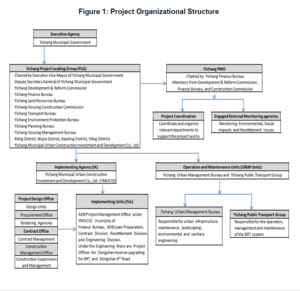Hubei-Yichang Sustainable Urban Transport Project: non-motorised transport measures (Yichang, China)

Area: urban
Date implemented: January 2017
How long from concept to implementation: 5 years
Relation between efforts undertaken and benefits achieved: good
What was done and how: Pedestrian and bicycle facilities (bicycle lanes and parking areas) were implemented along the bus rapid transit (BRT) corridor and at key intersections, supporting accessibility and safety of bus passengers and other non-motorised transport users. Car parking spaces (legal and illegal) were reclaimed to improve conditions for walking and cycling along the BRT line. This included new separated cycling paths, as well as the installation of street furniture that discourages illegal car parking. Bicycle parking stations and a bike sharing system were implemented along the BRT corridor and in the city. Funding was procured from municipal funds, a domestic state-owned bank (China Development Bank/Industrial and Commercial Bank of China), and a multilateral development bank (Asian Development Bank).
Why it worked to 'fast track' the innovation/measure: Top city leadership was directly involved in the implementation of the project and fully supported it. City leadership ensured that inter-agency coordination went smoothly. A special institutional setup was used to manage the project: a leading group, with its own headquarters and a Deputy Mayor in charge, was responsible for managing all other players in the project and liaising with funders to ensure implementation was in line with requirements.
Lessons learnt: A comprehensive study prior to planning enabled swift action to address the needs of the city, informed the project design, and helped convince shareholders through evidence-led planning. Strategic, low-cost options along major arteries can bring more value than extensive road building to accomodate personal transport options. It is possible to design for social inclusiveness by connecting areas underserved by public transport and sustainable modes to the transport network. Holistic interventions adressing several issues increase the impact of each single measure.
Tips for replication: Engage in Policy dialogue with potential funders.:Yichang changed the proposal from one focused on road building within the city to one based ona BRT system and bypass after dialogue with the Asian Development Band. Focus on a wholistic approach using several interlocked measures to tackle the issue. Comission exhaustive geological and ground surveys before construction to avoid delays during construction.
Sources or links:
https://development.asia/case-study/optimizing-road-use-congested-city
https://www.adb.org/projects/45023-002/main
https://www.itdp.org/city-transformations/yichang/
https://www.eltis.org/discover/case-studies/yichangs-holistic-award-winning-approach-sustainable-transport-china
Date implemented: January 2017
How long from concept to implementation: 5 years
Relation between efforts undertaken and benefits achieved: good
What was done and how: Pedestrian and bicycle facilities (bicycle lanes and parking areas) were implemented along the bus rapid transit (BRT) corridor and at key intersections, supporting accessibility and safety of bus passengers and other non-motorised transport users. Car parking spaces (legal and illegal) were reclaimed to improve conditions for walking and cycling along the BRT line. This included new separated cycling paths, as well as the installation of street furniture that discourages illegal car parking. Bicycle parking stations and a bike sharing system were implemented along the BRT corridor and in the city. Funding was procured from municipal funds, a domestic state-owned bank (China Development Bank/Industrial and Commercial Bank of China), and a multilateral development bank (Asian Development Bank).
Why it worked to 'fast track' the innovation/measure: Top city leadership was directly involved in the implementation of the project and fully supported it. City leadership ensured that inter-agency coordination went smoothly. A special institutional setup was used to manage the project: a leading group, with its own headquarters and a Deputy Mayor in charge, was responsible for managing all other players in the project and liaising with funders to ensure implementation was in line with requirements.
Lessons learnt: A comprehensive study prior to planning enabled swift action to address the needs of the city, informed the project design, and helped convince shareholders through evidence-led planning. Strategic, low-cost options along major arteries can bring more value than extensive road building to accomodate personal transport options. It is possible to design for social inclusiveness by connecting areas underserved by public transport and sustainable modes to the transport network. Holistic interventions adressing several issues increase the impact of each single measure.
Tips for replication: Engage in Policy dialogue with potential funders.:Yichang changed the proposal from one focused on road building within the city to one based ona BRT system and bypass after dialogue with the Asian Development Band. Focus on a wholistic approach using several interlocked measures to tackle the issue. Comission exhaustive geological and ground surveys before construction to avoid delays during construction.
Sources or links:






